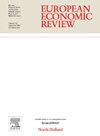货币政策对宏观经济风险的影响
IF 2.4
2区 经济学
Q1 ECONOMICS
引用次数: 0
摘要
货币政策扩张大大降低了宏观经济的下行风险,下行风险是指工业生产增长预测分布的中位数与第 5 个百分位数之间的差值。然而,与信贷息差冲击相比,货币政策扩张的影响幅度较小,我们发现信贷息差冲击是下行风险波动的主要驱动因素。因此,需要采取大规模的政策干预措施来稳定来自金融部门的风险,这将对价格和产出的稳定性造成不良后果。这些结论是利用美国数据和一种结合了量子回归和结构 VAR 分析的新型计量经济学方法得出的。本文章由计算机程序翻译,如有差异,请以英文原文为准。
The effects of monetary policy on macroeconomic risk
Monetary policy expansions significantly reduce macroeconomic downside risk, measured as the difference between the median and the 5th percentile of the industrial production growth forecast distribution. However, the effects are smaller in magnitude than those of credit spread shocks, which we find to be a major driver of fluctuations in downside risk. As a consequence, large policy interventions are required to stabilize risk originating from the financial sector, with undesirable consequences in terms of both price and output stability. These findings are obtained using US data and a novel econometric approach which combines quantile regressions and Structural VAR analysis.
求助全文
通过发布文献求助,成功后即可免费获取论文全文。
去求助
来源期刊

European Economic Review
ECONOMICS-
CiteScore
4.70
自引率
3.60%
发文量
170
期刊介绍:
The European Economic Review (EER) started publishing in 1969 as the first research journal specifically aiming to contribute to the development and application of economics as a science in Europe. As a broad-based professional and international journal, the EER welcomes submissions of applied and theoretical research papers in all fields of economics. The aim of the EER is to contribute to the development of the science of economics and its applications, as well as to improve communication between academic researchers, teachers and policy makers across the European continent and beyond.
 求助内容:
求助内容: 应助结果提醒方式:
应助结果提醒方式:


